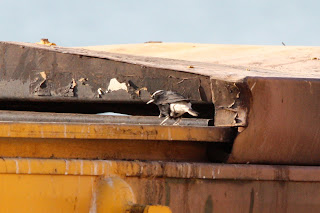Ray Mysterio managed to incorporate quite a bit of birding into the Israel wedding holiday. Absolutely dropped on at the brother in law's parents house which lies in the beautiful village of Hoffit, bordered by a beach, a river and a bit of bushy scrub wasteland. Most mornings I managed a quick one hour yomp around the village and I wasn't disappointed.
In March, Israel is alive with birds. Local specialties seen daily were Spur Winged Plover, Yellow Vented Bulbul, White Breasted Kingfisher, Jay (the eastern race with a 'tache!), Laughing Dove, Palestinian Sunbird, Syrian Pecker, Pied Kingfisher, Alpine Swift, Black Redstart, Hoopoe, Corn Bunting, Night Heron, Common Myna, Cretzschmar's Bunting and some of the commoner European passerines.
There were also some star wintering (or passage) birds - the big three of South East Europe - Wryneck (Grinch), Bluethroat and Nightingale.
Warblers were everywhere every day; Chiffchaff, Lesser Whitethroat, Reed, Fan Tailed, Sedge, Sardinian, Cetti's, Blackcap and the Graceful Prinia.
Star bird in Hoffit was a couple of pairs of Chukar Partridge in the scrub - my first lifer of the holidays.
After the family wedding we bashed down to the Dead Sea, about 2.5 hours drive south. Hot, sandy and full of birds. First morning I was out the door at 6am into the nearest Wadi. Migrants and desert specialties everywhere.
Highlights include a group of male Trumpeter Finch lekking (displaying) while the females watched.
A White-Crowned Wheatear on this skip - a real South Israel specialty. Also in the Wadi Eastern Bonelli's Warbler, Blackstart, Tristram's Grackle, Scrub Warbler, Yellow Wagtail, Unidentified Larks over and star bird Little Green Bee-Eater. I was to get better views on Eilat, but the lifer count was now up to 6. Next up was a pair of Egyptian Nightjars feeding on months around the hotel balcony from about 7pm onwards. Mixing in amongst the massive bats they were very distinctive with their pale plumage, long tail and pointed wings.
Second morning we scheduled a quick hike up Masada, a roman fortress at the top of a mountain. Sim and I set off at 5.30 and were first up to watch the sun rise. While the guidebook tried to point me towards the ancient ruins and amazing story of Masada I was way more interested to drop on to a pair of Egyptian Vultures taking an early morning stance outside there nest - amazing!!
Fan Tailed Ravens displayed all round us and I added Rock Martin, Swift and another group of Cretzschmar's on the way down.
A few more days in Hoffit yielded some photo opportunities. A cracking male P Sunbird and this Syrian Wood posed nicely. While I papped some more of the local residents below.




































 Dive bomb!
Dive bomb! Gotcha..
Gotcha..








